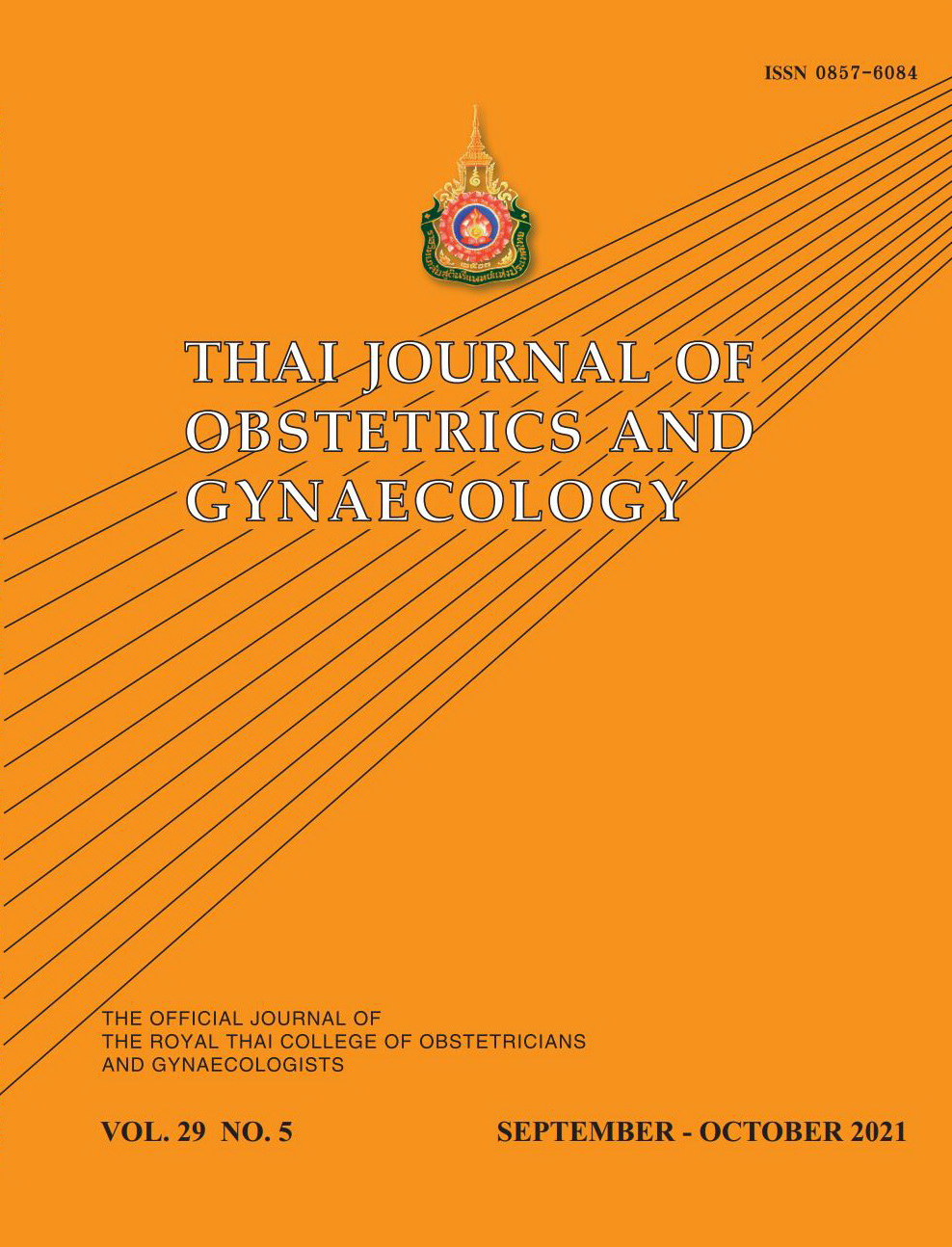Prediction of Successful Normal Vaginal Delivery by Ultrasonographic Measurement of Occiput-spine Angle during First Stage of Labor
Main Article Content
Abstract
Objectives: To determine the accuracy of occiput-spine angle (OSA) measurement during the first stage of labor for predicting the course and outcome of labor.
Materials and Methods: A study was carried out in singleton pregnant women with cephalic presentation, who underwent labor between 37 weeks and 41 weeks and 6 days, from February 2018 to January 2019. Transabdominal ultrasound was performed to measure the OSA. The first examination was done at a cervical dilatation of 3-6 cm, and it was repeated at following 2 hours. The diagnostic values of the OSA as a predictor of the course and outcome of labor were analyzed.
Results: A total of 330 cases were studied, and 41 (12%) of them underwent a cesarean section due to cephalopelvic disproportion (CPD). There was no significant difference in mean OSA among the vaginal delivery and cesarean section groups (110.7 ± 11.1 degrees vs 110 ± 9.1 degrees, p = 0.649). The sensitivity of an OSA ≥ 100 degrees for predicting vaginal delivery was 83.7%, but its specificity was only 17.1%. The combination of an OSA ≥ 100 degrees, multiparity, and no induction of labor could predict vaginal delivery with a positive likelihood ratio 3.6.
Conclusion: The mean OSA among the vaginal delivery and cesarean section groups was not significantly different. The OSA alone was not a good predictor for vaginal delivery.
Article Details
References
Ghi T, Bellussi F, Azzarone C, Krsmanovic J, Franchi L, Youssef A, et al. The “occiput- spine angle”: a new sonographic index of fetal head deflexion during the first stage of labor. Am J Obstet Gynecol 2016;215:1-7.
Maged AM, Soliman EM, Abdellatif AA, Nabil M, Said OI, Mohesen MN, et al. Measurement of the fetal occiput-spine angle during the first stage of labor as predictor of the progress and outcome of labor. J Matern Fetal Neonal Med 2018;32:2332-7.
Eggebø TM, Hassan WA, Salvesen KA, Torkildsen EA, Østborg TB, Lees CC. Prediction of delivery mode by ultrasound-assessed fetal position in nulliparous women with prolonged first stage of labor. Ultrasound Obstet Gynecol 2015;46:606-10.
Marsoosi V, Pirjani R, Mansouri B, Eslamian L, Jamal A, Heidari R, et al. Role of ‘angle of progression’ in prediction of delivery mode. J Obstet Gynaecol Res 2015;41:1693-9.
Adam G, Sirbu O, Voicu C, Iliescu D, Tudorache S, Cernea N. Intrapartum ultrasound assessment of fetal head position, Tip the scale: natural or instrumental delivery? Curr Health Sci J 2014;40:18-22.
Yonetani N, Yamamoto R, Murata M, Nakajima E, Taguchi T, Ishii K, et al. Prediction of time to delivery by transperineal ultrasound in second stage of labor. Ultrasound Obstet Gynecol 2017;49:246-51.
Kahrs BH, Usman S, Ghi T, Youssef A, Torkildsen EA, Lindtjørn E, et al. Sonographic prediction of outcome of vacuum deliveries: a multicenter, prospective cohort study. Am J Obstet Gynecol 2017;217:1-10.
Betrán AP, Ye J, Moller AB, Zhang J, Gülmezoglu AM, Torloni MR. The increasing trend in caesarean section rates: global, regional and national estimates: 1990-2014. PLoS One 2016;11:1-12.
Yukaew N. Cesarean section rate according to Robson’s classification. J Med Assoc Thai 2017;7:262-71.
Barber EL, Lundsberg LS, Belanger K, Pettker CM, Funai EF, Illuzzi JL. Indications contributing to the increasing cesarean delivery rate. Obstet Gynecol 2011;118:29-38.
Caughey AB, Cahill AG, Guise JM, Rouse DJ. American College of Obstetricians and Gynecologists, Society for Maternal-Fetal Medicine. Safe prevention of the primary cesarean delivery. Obstet Gynecol 2014;123:693-711.
Cunningham FG, Leveno KJ, Bloom SL, Spong CY, Dashe JS, Hoffman BL, et al, editors. Williams obstetrics. 24th ed. Philadelphia: McGraw Hill; 2014:455-70.
Tongsong T. Physiology of labor. Obstetrics. 5th ed. Bangkok: Laxmirung 2555:126-8.

